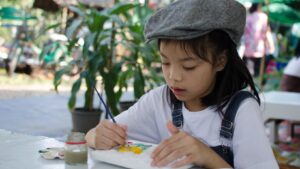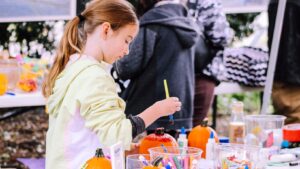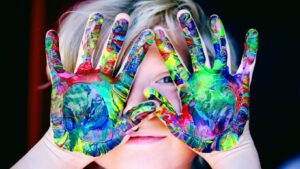Imagine a world where crayons become magic wands, guiding young minds through the realms of creativity. That’s the power of arts in the lives of children. It’s not just about colors and shapes; it’s about exploring, expressing, and discovering the world in a whole new light.

Creativity And Arts With Young Children
Creativity in early childhood is akin to a seed, only bearing fruit when nurtured properly. Just as a young tree’s roots reach out and explore the soil, a child’s mind, when stimulated by creativity and art, breaks boundaries and explores different regions of thought and expression.
Benefits of Artistic Expression
Engaging in art fosters an environment where children unlock their potential, experiencing numerous positive developmental aspects. Artistic expression catalyses the release of imagination, enabling children to traverse fascinating landscapes of creativity. Youngsters build a vital skill, communication, as they learn to articulate ideas and emotions via colored strokes on pieces of paper. This type of self-expression deeply impacts children’s emotional well-being as well.
For instance, a child might draw a family portrait with big smiles and bright colors. The picture, though simple, speaks volumes about a child’s feelings towards their family: love, delight, and warmth. Hence, visualization meets verbalization in the world of art.
Cognitive and Emotional Growth Through Creativity
The roots of cognitive growth stretch deep into the soil of creativity. Early exposure to arts and creativity aids in the enhancement of children’s cognitive abilities. As young kids use various art tools, they cultivate fine motor skills. Additionally, their decision-making abilities sharpen as they choose different colors and shapes to represent their thoughts and feelings.
Emotionally, creativity becomes an outlet for children to express their happiness, anger, or sadness without using words, reflecting their emotional states vividly. Peering into a child’s artwork often provides a window into their world, packed with unspoken emotions and stories. Over time, this process equips kids with the ability to comprehend, interpret, and respond to emotions—an invaluable life skill.

How to Foster Creativity at Home and in the Classroom
Keeping the atmosphere conducive to art making incorporates elements that inspire a child. So, here are some ways on how to achieve that.
Creating an Inspiring Environment
An inspiring environment, conducive to nurturing creativity, assists children’s progress in exploring art forms. In a home or classroom setting, flood the area with visually stimulating materials, like beautiful prints of artworks or colorful fabrics. Playing soft music helps set a creative mood. Remember to leave space as well for kids to display their creations, giving them a sense of pride and achievement. Most importantly, make the environment safe and comfortable.
Choosing Age-Appropriate Art Supplies
Choosing age-appropriate art supplies further encourages a child’s artistic exploration. For toddlers, thick crayons and large sheets of paper serve as great introductory tools. These help develop their fine motor skills without overwhelming them. Preschoolers enjoy manipulative materials like clay and felt. Older children can experiment with higher level tools like watercolors or charcoal. Always prioritize safety by checking if the materials are non-toxic.
When these strategies are in place, foster creativity in children sounds like music to their ears – an exciting challenge rather than a daunting task. And though creativity can’t be measured quantitatively, you’ll see the qualitative growth in their imaginations, problem-solving skills, and of course, their art. Art, after all, reflects the soul of its creator.

Far More Than Just Play
Fostering creativity and arts in young children isn’t just about keeping them busy. It’s a powerful tool for cognitive growth and self-expression. By introducing children to various art forms, they’re given a platform to convey their thoughts and emotions. At home or in the classroom, an environment rich in visually stimulating materials, soothing music, and age-appropriate art supplies, can transform the learning process into an exciting challenge. It’s through this journey that children’s imaginations flourish, their problem-solving skills sharpen, and their artistic expressions evolve. So, let’s continue to encourage the artists of tomorrow, today. Because when it comes to creativity and arts with young children, the benefits are far more than just child’s play.

